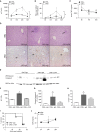The Lung-Liver Axis: A Requirement for Maximal Innate Immunity and Hepatoprotection during Pneumonia
- PMID: 25607543
- PMCID: PMC4566062
- DOI: 10.1165/rcmb.2014-0195OC
The Lung-Liver Axis: A Requirement for Maximal Innate Immunity and Hepatoprotection during Pneumonia
Abstract
The hepatic acute-phase response (APR), stimulated by injury or inflammation, is characterized by significant changes in circulating acute-phase protein (APP) concentrations. Although individual functions of liver-derived APPs are known, the net consequence of APP changes is unclear. Pneumonia, which induces the APR, causes an inflammatory response within the airspaces that is coordinated largely by alveolar macrophages and is typified by cytokine production, leukocyte recruitment, and plasma extravasation, the latter of which may enable delivery of hepatocyte-derived APPs to the infection site. To determine the functional significance of the hepatic APR during pneumonia, we challenged APR-null mice lacking hepatocyte signal transducer and activator of transcription 3 (STAT3) and v-rel avian reticuloendotheliosis viral oncogene homolog A (RelA) with Escherichia coli in the airspaces. APR-null mice displayed ablated APP induction, significantly increased mortality, liver injury and apoptosis, and a trend toward increased bacterial burdens. TNF-α neutralization reversed hepatotoxicity, but not mortality, suggesting that APR-dependent survival is not solely due to hepatoprotection. After a milder (nonlethal) E. coli infection, hepatocyte-specific mutations decreased APP concentrations and pulmonary inflammation in bronchoalveolar lavage fluid. Cytokine expression in airspace macrophages, but not other airspace or circulating cells, was significantly dependent on APP extravasation into the alveoli. These data identify a novel signaling axis whereby the liver response enhances macrophage activation and pulmonary inflammation during pneumonia. Although hepatic acute-phase changes directly curb injury induced by TNF-α in the liver itself, APPs downstream of these same signals promote survival in association with innate immunity in the lungs, thus demonstrating a critical role for the lung-liver axis during pneumonia.
Keywords: acute-phase response; inflammation; liver; pneumonia.
Figures







Similar articles
-
Activation of Hepatic STAT3 Maintains Pulmonary Defense during Endotoxemia.Infect Immun. 2015 Oct;83(10):4015-27. doi: 10.1128/IAI.00464-15. Epub 2015 Jul 27. Infect Immun. 2015. PMID: 26216424 Free PMC article.
-
Mechanisms of the hepatic acute-phase response during bacterial pneumonia.Infect Immun. 2009 Jun;77(6):2417-26. doi: 10.1128/IAI.01300-08. Epub 2009 Mar 16. Infect Immun. 2009. PMID: 19289507 Free PMC article.
-
Alveolar epithelial STAT3, IL-6 family cytokines, and host defense during Escherichia coli pneumonia.Am J Respir Cell Mol Biol. 2008 Jun;38(6):699-706. doi: 10.1165/rcmb.2007-0365OC. Epub 2008 Jan 10. Am J Respir Cell Mol Biol. 2008. PMID: 18192501 Free PMC article.
-
Macrophage-epithelial interactions in pulmonary alveoli.Semin Immunopathol. 2016 Jul;38(4):461-9. doi: 10.1007/s00281-016-0569-x. Epub 2016 May 12. Semin Immunopathol. 2016. PMID: 27170185 Free PMC article. Review.
-
Acute-phase protein synthesis: a key feature of innate immune functions of the liver.Biol Chem. 2021 Jul 29;402(9):1129-1145. doi: 10.1515/hsz-2021-0209. Print 2021 Aug 26. Biol Chem. 2021. PMID: 34323429 Review.
Cited by
-
Critical Role of IL-22/IL22-RA1 Signaling in Pneumococcal Pneumonia.J Immunol. 2016 Sep 1;197(5):1877-83. doi: 10.4049/jimmunol.1600528. Epub 2016 Jul 25. J Immunol. 2016. PMID: 27456484 Free PMC article.
-
A hepatocyte-specific transcriptional program driven by Rela and Stat3 exacerbates experimental colitis in mice by modulating bile synthesis.Elife. 2024 Aug 13;12:RP93273. doi: 10.7554/eLife.93273. Elife. 2024. PMID: 39137024 Free PMC article.
-
Liver-Dependent Lung Remodeling during Systemic Inflammation Shapes Responses to Secondary Infection.J Immunol. 2021 Oct 1;207(7):1891-1902. doi: 10.4049/jimmunol.2100254. Epub 2021 Sep 1. J Immunol. 2021. PMID: 34470857 Free PMC article.
-
Liver-lung interactions in acute respiratory distress syndrome.Intensive Care Med Exp. 2020 Dec 18;8(Suppl 1):48. doi: 10.1186/s40635-020-00337-9. Intensive Care Med Exp. 2020. PMID: 33336286 Free PMC article.
-
Extra-pulmonary control of respiratory defense.Cell Immunol. 2024 Jul-Aug;401-402:104841. doi: 10.1016/j.cellimm.2024.104841. Epub 2024 Jun 7. Cell Immunol. 2024. PMID: 38878619 Free PMC article. Review.
References
Publication types
MeSH terms
Substances
Grants and funding
- R01 HL104053/HL/NHLBI NIH HHS/United States
- R01-HL079392/HL/NHLBI NIH HHS/United States
- T32 HL007035/HL/NHLBI NIH HHS/United States
- T32 AI089673/AI/NIAID NIH HHS/United States
- T32-AI007309/AI/NIAID NIH HHS/United States
- T32-HL007035/HL/NHLBI NIH HHS/United States
- R01-HL111449/HL/NHLBI NIH HHS/United States
- R00 HL092956/HL/NHLBI NIH HHS/United States
- R01 HL068153/HL/NHLBI NIH HHS/United States
- T32 AI007309/AI/NIAID NIH HHS/United States
- R01 HL111449/HL/NHLBI NIH HHS/United States
- R00-HL092956/HL/NHLBI NIH HHS/United States
- R01 HL079392/HL/NHLBI NIH HHS/United States
LinkOut - more resources
Full Text Sources
Medical
Miscellaneous

